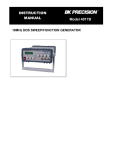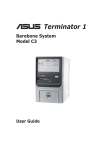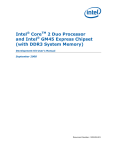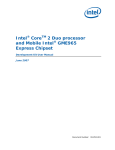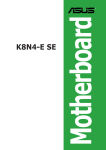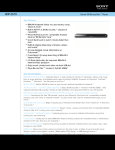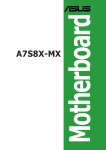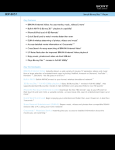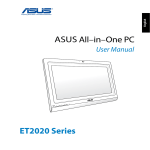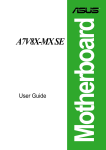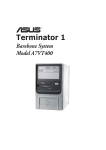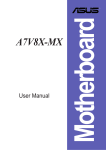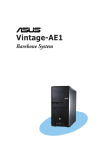Download Asus A8N-E Specifications
Transcript
Motherboard A8NE-FM E1834 First Edition V1 November 2004 Copyright © 2004 ASUSTeK COMPUTER INC. All Rights Reserved. No part of this manual, including the products and software described in it, may be reproduced, transmitted, transcribed, stored in a retrieval system, or translated into any language in any form or by any means, except documentation kept by the purchaser for backup purposes, without the express written permission of ASUSTeK COMPUTER INC. (“ASUS”). Product warranty or service will not be extended if: (1) the product is repaired, modified or altered, unless such repair, modification of alteration is authorized in writing by ASUS; or (2) the serial number of the product is defaced or missing. ASUS PROVIDES THIS MANUAL “AS IS” WITHOUT WARRANTY OF ANY KIND, EITHER EXPRESS OR IMPLIED, INCLUDING BUT NOT LIMITED TO THE IMPLIED WARRANTIES OR CONDITIONS OF MERCHANTABILITY OR FITNESS FOR A PARTICULAR PURPOSE. IN NO EVENT SHALL ASUS, ITS DIRECTORS, OFFICERS, EMPLOYEES OR AGENTS BE LIABLE FOR ANY INDIRECT, SPECIAL, INCIDENTAL, OR CONSEQUENTIAL DAMAGES (INCLUDING DAMAGES FOR LOSS OF PROFITS, LOSS OF BUSINESS, LOSS OF USE OR DATA, INTERRUPTION OF BUSINESS AND THE LIKE), EVEN IF ASUS HAS BEEN ADVISED OF THE POSSIBILITY OF SUCH DAMAGES ARISING FROM ANY DEFECT OR ERROR IN THIS MANUAL OR PRODUCT. SPECIFICATIONS AND INFORMATION CONTAINED IN THIS MANUAL ARE FURNISHED FOR INFORMATIONAL USE ONLY, AND ARE SUBJECT TO CHANGE AT ANY TIME WITHOUT NOTICE, AND SHOULD NOT BE CONSTRUED AS A COMMITMENT BY ASUS. ASUS ASSUMES NO RESPONSIBILITY OR LIABILITY FOR ANY ERRORS OR INACCURACIES THAT MAY APPEAR IN THIS MANUAL, INCLUDING THE PRODUCTS AND SOFTWARE DESCRIBED IN IT. Products and corporate names appearing in this manual may or may not be registered trademarks or copyrights of their respective companies, and are used only for identification or explanation and to the owners’ benefit, without intent to infringe. ii Contents Notices ................................................................................................. v Safety information .............................................................................. vi A8NE-FM specifications summary ...................................................... vii Chapter 1: Hardware information 1.1 Before you proceed .............................................................. 1-2 1.2 Motherboard overview .......................................................... 1-3 1.3 1.4 1.5 1.2.1 Placement direction ................................................ 1-3 1.2.2 Screw holes ............................................................ 1-3 1.2.3 Motherboard layout ................................................ 1-4 1.2.4 Layout contents ..................................................... 1-5 Central Processing Unit (CPU) .............................................. 1-7 1.3.1 Installing the CPU .................................................... 1-7 1.3.2 Installing the heatsink and fan ................................ 1-9 System memory ................................................................. 1-12 1.4.1 Overview ............................................................... 1-12 1.4.2 Memory configurations ......................................... 1-12 1.4.3 Installing a DIMM ................................................... 1-13 1.4.4 Removing a DIMM ................................................. 1-13 Expansion slots ................................................................... 1-14 1.5.1 Installing an expansion card .................................. 1-14 1.5.2 Configuring an expansion card .............................. 1-14 1.5.4 PCI Express x16 slot ............................................. 1-16 1.5.3 PCI slots ................................................................ 1-16 1.6 Jumpers .............................................................................. 1-17 1.7 Connectors ......................................................................... 1-20 1.7.1 Rear panel connectors .......................................... 1-20 1.7.2 Internal connectors ............................................... 1-22 iii Contents Chapter 2: 2.1 2.2 2.3 2.4 2.5 2.6 2.7 iv BIOS setup Managing and updating your BIOS ........................................ 2-2 2.1.1 Creating a bootable floppy disk .............................. 2-2 2.1.2 AwardBIOS Flash Utility .......................................... 2-3 2.1.3 ASUS CrashFree BIOS 2 utility ................................ 2-7 BIOS Setup program ............................................................. 2-8 2.2.1 BIOS menu bar ........................................................ 2-9 2.2.2 Legend bar ............................................................. 2-9 Main Menu ........................................................................... 2-11 2.3.1 System Time ......................................................... 2-11 2.3.2 System Date ......................................................... 2-11 2.3.3 Legacy Diskette A ................................................ 2-11 2.3.4 Installed Memory .................................................. 2-11 2.3.5 Primary and Secondary IDE Master/Slave ............. 2-12 2.3.6 First, Second, Third, and Fourth SATA Master ..... 2-14 Advanced Menu .................................................................. 2-15 2.4.1 CPU configuration ................................................. 2-16 2.4.2 Chipset configuration ........................................... 2-17 2.4.3 PCIPnP ................................................................... 2-19 2.4.4 Onboard device configuration ............................. 2-20 Power Menu ........................................................................ 2-25 2.5.1 APM configuration ................................................ 2-26 2.5.2 Hardware monitor ................................................. 2-28 Boot Menu .......................................................................... 2-30 2.6.1 Boot Device Priority .............................................. 2-30 2.6.2 Removable drives ................................................. 2-31 2.6.3 Hard Disk Drives ................................................... 2-31 2.6.4 CD-ROM drives ...................................................... 2-32 2.6.5 Boot settings configuration .................................. 2-32 2.6.6 Security ................................................................ 2-34 Exit menu ........................................................................... 2-35 Notices Federal Communications Commission Statement This device complies with Part 15 of the FCC Rules. Operation is subject to the following two conditions: • This device may not cause harmful interference, and • This device must accept any interference received including interference that may cause undesired operation. This equipment has been tested and found to comply with the limits for a Class B digital device, pursuant to Part 15 of the FCC Rules. These limits are designed to provide reasonable protection against harmful interference in a residential installation. This equipment generates, uses and can radiate radio frequency energy and, if not installed and used in accordance with manufacturer’s instructions, may cause harmful interference to radio communications. However, there is no guarantee that interference will not occur in a particular installation. If this equipment does cause harmful interference to radio or television reception, which can be determined by turning the equipment off and on, the user is encouraged to try to correct the interference by one or more of the following measures: • Reorient or relocate the receiving antenna. • Increase the separation between the equipment and receiver. • Connect the equipment to an outlet on a circuit different from that to which the receiver is connected. • Consult the dealer or an experienced radio/TV technician for help. The use of shielded cables for connection of the monitor to the graphics card is required to assure compliance with FCC regulations. Changes or modifications to this unit not expressly approved by the party responsible for compliance could void the user’s authority to operate this equipment. Canadian Department of Communications Statement This digital apparatus does not exceed the Class B limits for radio noise emissions from digital apparatus set out in the Radio Interference Regulations of the Canadian Department of Communications. This class B digital apparatus complies with Canadian ICES-003. v Safety information Electrical safety • To prevent electrical shock hazard, disconnect the power cable from the electrical outlet before relocating the system. • When adding or removing devices to or from the system, ensure that the power cables for the devices are unplugged before the signal cables are connected. If possible, disconnect all power cables from the existing system before you add a device. • Before connecting or removing signal cables from the motherboard, ensure that all power cables are unplugged. • Seek professional assistance before using an adapter or extension cord. These devices could interrupt the grounding circuit. • Make sure that your power supply is set to the correct voltage in your area. If you are not sure about the voltage of the electrical outlet you are using, contact your local power company. • If the power supply is broken, do not try to fix it by yourself. Contact a qualified service technician or your retailer. Operation safety • Before installing the motherboard and adding devices on it, carefully read all the manuals that came with the package. • Before using the product, make sure all cables are correctly connected and the power cables are not damaged. If you detect any damage, contact your dealer immediately. • To avoid short circuits, keep paper clips, screws, and staples away from connectors, slots, sockets and circuitry. • Avoid dust, humidity, and temperature extremes. Do not place the product in any area where it may become wet. • Place the product on a stable surface. • If you encounter technical problems with the product, contact a qualified service technician or your retailer. vi A8NE-FM specifications summary CPU Socket 939 for AMD Athlon™ 64FX/AMD Athlon™ 64 processor Supports AMD 64 architecture that enables simultaneous 32-bit and 64-bit architecture Chipset NVIDIA® nForce4 (CK8-04 Standard - A02) Front Side Bus 800 MHz Memory Dual-channel memory architecture 2 or optional 4 x 184-pin DIMM sockets support non-ECC unbufferred 400/333 MHz DDR memory modules Supports up to 4 GB system memory Expansion slots 1 x PCI Express x16 slot for discrete graphics card 3 x PCI slots Storage NVIDIA ® nForce4® chipset supports: - 4 x Ultra DMA 133/100/66/33 hard disk drives - 4 x Serial ATA drives with RAID 0, RAID 1, RAID 1+0, and JBOD configurations Audio Realtek® ALC655 6-channel CODEC 1 x Coaxial S/PDIF out port LAN Realtek® 8201 CL 10/100 Mbps PHY LAN controller IEEE 1394 Supports up to 8 USB 2.0 ports USB BIOS T1 1394a controller supports: - 2 x IEEE 1394a ports features Special features Rear panel 4 Mb Flash ROM, Award BIOS, LPC ASUS My Logo™ ASUS EZ Flash ASUS Crash Free BIOS 2 ASUS CPU Overheating Protection (C.O.P.) 1 x PS/2 mouse port 1 x Parallel port 1 x IEEE 1394a port 1 x LAN (RJ-45) port 4 x USB 2.0 ports 1 x Coaxial S/PDIF Out port 1 x Serial (COM1) port 1 x PS/2 keyboard port 6-Channel audio ports (continued on the next page) vii A8NE-FM specifications summary Internal connectors 1 x Floppy disk drive connector 2 x IDE connectors 4 x Serial ATA connectors 1 x CPU fan connector 1 x System fan connector 1 x Chip fan connector 2 x USB connectors 1 x IEEE 1394a connector 1 x 24-pin ATX power connector 1 x 4-pin ATX 12V power connector 1 x Internal audio connector 1x Front panel audio connector 1 x System panel connector Form factor uATX form factor: 9.6 in x 9.6 in (24.4 cm x 24.4 cm) *Specifications are subject to change without notice. viii This chapter lists the hardware setup procedures that you have to perform when installing system components. It includes description of the jumpers and connectors on the motherboard. 1 Hardware information 1.1 Before you proceed Take note of the following precautions before you install motherboard components or change any motherboard settings. 1-2 • Unplug the power cord from the wall socket before touching any component. • Use a grounded wrist strap or touch a safely grounded object or a metal object, such as the power supply case, before handling components to avoid damaging them due to static electricity • Hold components by the edges to avoid touching the ICs on them. • Whenever you uninstall any component, place it on a grounded antistatic pad or in the bag that came with the component. • Before you install or remove any component, ensure that the ATX power supply is switched off or the p o w e r c o r d i s d e t a c h e d f r o m t h e p o w e r s u p p l y . Failure to do so may cause severe damage to the motherboard, peripherals, and/or components. Chapter 1: Hardware information 1.2 Motherboard overview Before you install the motherboard, study the configuration of your chassis to ensure that the motherboard fits into it. Refer to the chassis documentation before installing the motherboard. Make sure to unplug the power cord before installing or removing the motherboard. Failure to do so can cause you physical injury and damage motherboard components. 1.2.1 Placement direction When installing the motherboard, make sure that you place it into the chassis in the correct orientation. The edge with external ports goes to the rear part of the chassis as indicated in the image below. 1.2.2 Screw holes Place 10 screws into the holes indicated by circles to secure the motherboard to the chassis. Do not overtighten the screws! Doing so can damage the motherboard. Place this side towards the rear of the chassis A8NE-FM ® ASUS A8NE-FM 1-3 1.2.3 Motherboard layout 24.5cm (9.6in) ASUS A8000 COM1 A ATXPWRCON1 FLOPPY1 24.5cm (9.6in) 4Mb BIOS IDE2 SYS_FAN DDR DIMM_B2 (64 bit,184-pin module) USBLANCON DDR DIMM_A2 (64 bit,184-pin module) F_USB12 DDR DIMM_B1 (64 bit,184-pin module) SPDIF_O DDR DIMM_A1 (64 bit,184-pin module) Socket 939 USBPW12 USBPW34 P PARALLEL L PORT A ATX12V CPU_FAN * * PCIESLOT1 VIA VT6307 IDE1 T Top:Line In Center:Line Out Bottom:Mic In A8NE-FM CR2032 3V Lithium Cell CMOS Power ACL655 PCI_SLOT3 FAUDIO BIOS_R SATA3 ® SATA2 PCI_SLOT2 SATA4 IE1394_2 nVIDIA CK804 SATA1 CHIP_FAN PCI_SLOT1 BUZZER1 CLPSW AUX * optional 1-4 Chapter 1: Hardware information 1.2.4 Layout contents Slots Page 1. DDR DIMM slots 1-12 2. PCI slots 1-16 3. PCI Express slot 1-16 Jumpers Page 1. Clear RTC RAM (3-pin CLRTC1) 1-17 2. Clear password (3-pin CLPSW) 1-18 3. USB device wake-up (3-pin USBPW12, USBPW34, USBPW56, USBPW78) 1-18 4. BIOS Recovery (3-pin BIOS_R) 1-19 Rear panel connectors Page 1. PS/2 mouse port 1-20 2. Parallel port 1-20 3. IEEE 1394a port 1-20 4. LAN (RJ-45) port 1-20 5. Line In port 1-20 6. Line Out port 1-20 7. Microphone port 1-20 8. USB 2.0 ports 3 and 4 1-21 9. USB 2.0 ports 1 and 2 1-21 10. Coaxial S/PDIF Out port 1-21 11. Serial port 1-21 12. PS/2 keyboard port 1-21 ASUS A8NE-FM 1-5 1-6 Internal connectors Page 1. Floppy disk drive connector (34-1 pin FLOPPY1) 1-22 2. IDE connectors (40-1 pin IDE1, IDE2) 1-23 3. Serial ATA connectors (7-pin SATA1, SATA2, SATA3, SATA4) 1-24 4. CPU fan connector (3-pin CPU_FAN) 1-25 5. System fan connector (3-pin SYS_FAN) 1-25 6. Chip fan connector (2-pin CHIP_FAN) 1-25 7. USB connectors (10-1 pin USB78, USB56) 1-26 8. IEEE 1394a connector (10-1 pin IE1394_2) 1-26 9. ATX power connectors (24-pin ATXPWRCON1, 4-pin ATX12V1) 1-27 10. Internal audio connector (4-pin AUX) 1-28 11. Front panel audio connector (10-1 pin FPAUDIO) 1-28 12. System panel connector (10-1 pin F_PANEL1) 1-29 Chapter 1: Hardware information 1.3 Central Processing Unit (CPU) The motherboard comes with a surface mount 939-pin Zero Insertion Force (ZIF) socket designed for the AMD Athlon™ 64FX or AMD Athlon 64™ processor. The 128-bit-wide data paths of these processors can run applications faster than processors with only 32-bit or 64-bit wide data paths. Take note of the marked corner (with gold triangle) on the CPU. This mark should match a specific corner on the socket to ensure correct installation. Gold triangle 1.3.1 Installing the CPU To install a CPU: 1. Locate the CPU socket on the motherboard. A8NE-FM ® A8NE-FM CPU Socket 939 ASUS A8NE-FM 1-7 2. Unlock the socket by pressing the lever sideways, then lift it up to a 90°-100° angle. Socket lever Make sure that the socket lever is lifted up to 90°-100° angle; otherwise the CPU does not fit in completely. 3. Position the CPU above the socket such that the CPU corner with the gold triangle matches the socket corner with a small triangle. 4. Carefully insert the CPU into the socket until it fits in place. Gold triangle Small triangle The CPU fits only in one correct orientation. DO NOT force the CPU into the socket to prevent bending the pins and damaging the CPU! 5. 1-8 When the CPU is in place, push down the socket lever to secure the CPU. The lever clicks on the side tab to indicate that it is locked. Chapter 1: Hardware information 1.3.2 Installing the heatsink and fan The AMD Athlon™ 64FX or AMD Athlon 64™ processor requires a specially designed heatsink and fan assembly to ensure optimum thermal condition and performance. Make sure that you use only qualified heatsink and fan assembly. To install the CPU heatsink and fan: 1. Place the heatsink on top of the installed CPU, making sure that the heatsink fits properly on the retention module base. • The retention module base is already installed on the motherboard upon purchase. • You do not have to remove the retention module base when installing the CPU or installing other motherboard components. • If you purchased a separate CPU heatsink and fan assembly, make sure that a Thermal Interface Material is properly applied to the CPU heatsink or CPU before you install the heatsink and fan assembly. CPU fan CPU heatsink Retention module base Retention bracket Retention bracket lock Your boxed CPU heatsink and fan assembly should come with installation instructions for the CPU, heatsink, and the retention mechanism. If the instructions in this section do not match the CPU documentation, follow the latter. ASUS A8NE-FM 1-9 2. Attach one end of the retention bracket to the retention module base. 3. Align the other end of the retention bracket (near the retention bracket lock) to the retention module base. A clicking sound denotes that the retention bracket is in place. Make sure that the fan and heatsink assembly perfectly fits the retention mechanism module base, otherwise you cannot snap the retention bracket in place. 4. 1-10 Push down the retention bracket lock on the retention mechanism to secure the heatsink and fan to the module base. Chapter 1: Hardware information 5. When the fan and heatsink assembly is in place, connect the CPU fan cable to the connector on the motherboard labeled CPU_FAN. A8NE-FM ® FAN_TACF1 FANPWR GND CPU_FAN A8NE-FM CPU fan connector Do not forget to connect the CPU fan connector! Hardware monitoring errors can occur if you fail to plug this connector. ASUS A8NE-FM 1-11 1.4 System memory 1.4.1 Overview The motherboard comes with four 184-pin Double Data Rate (DDR) Dual Inline Memory Modules (DIMM) sockets. The following figure illustrates the location of the sockets: A8NE-FM Channel Sockets Channel A DIMM_A1 and DIMM_B1 Channel B DIMM_A2 and DIMM_B2 1.4.2 DIMM_B2 DIMM_A2 DIMM_B1 A8NE-FM 184-pin DDR DIMM sockets DIMM_A1 ® Memory configurations You may install 256 MB, 512 MB and 1 GB unbuffered non-ECC DDR DIMMs into the DIMM sockets using the memory configurations in this section. 1-12 • For dual-channel configuration, the total size of memory module(s) installed per channel must be the same for better performance (DIMM_A1+DIMM_B1=DIMM_A2+DIMM_B2). • Always install DIMMs with the same CAS latency. For optimum compatibility, we recommend that you obtain memory modules from the same vendor. Refer to the DDR400 Qualified Vendors List on the next page for details. • Due to chipset resource allocation, the system may detect less than 4 GB of system memory when you installed four 1 GB DDR memory modules. • Due to chipset limitation, this motherboard does not support DIMM modules with 128 Mb memory chips or double-sided x16 memory chips. • With the 4 DIMM slot, the DIMM slots DIMM_A2 and DIMM_B2 are always to be populated in pairs. Chapter 1: Hardware information 1.4.3 Installing a DIMM Make sure to unplug the power supply before adding or removing DIMMs or other system components. Failure to do so may cause severe damage to both the motherboard and the components. 2 1. Unlock a DIMM socket by pressing the retaining clips outward. 2. Align a DIMM on the socket such that the notch on the DIMM matches the break on the socket. DDR DIMM notch 1 1 Unlocked retaining clip A DDR DIMM is keyed with a notch so that it fits in only one direction. DO NOT force a DIMM into a socket to avoid damaging the DIMM. 3. Firmly insert the DIMM into the socket until the retaining clips snap back in place and the DIMM is properly seated. Locked retaining clip 1.4.4 Removing a DIMM 2 To remove a DIMM: 1. Simultaneously press the retaining clips outward to unlock the DIMM. 1 1 DDR DIMM notch Support the DIMM lightly with your fingers when pressing the retaining clips. The DIMM might get damaged when it flips out with extra force. 2. Remove the DIMM from the socket. ASUS A8NE-FM 1-13 1.5 Expansion slots In the future, you may need to install expansion cards. The following sub-sections describe the slots and the expansion cards that they support. Make sure to unplug the power cord before adding or removing expansion cards. Failure to do so may cause you physical injury and damage motherboard components. 1.5.1 Installing an expansion card To install an expansion card: 1. Before installing the expansion card, read the documentation that came with it and make the necessary hardware settings for the card. 2. Remove the system unit cover (if your motherboard is already installed in a chassis). 3. Remove the bracket opposite the slot that you intend to use. Keep the screw for later use. 4. Align the card connector with the slot and press firmly until the card is completely seated on the slot. 5. Secure the card to the chassis with the screw you removed earlier. 6. Replace the system cover. 1.5.2 Configuring an expansion card After installing the expansion card, configure it by adjusting the software settings. 1. Turn on the system and change the necessary BIOS settings, if any. See Chapter 2 for information on BIOS setup. 2. Assign an IRQ to the card. Refer to the tables on the next page. 3. Install the software drivers for the expansion card. 1-14 Chapter 1: Hardware information Standard interrupt assignments IRQ Priority 0 1 2 3 4 5 6 7 8 9 10 11 12 13 14 15 1 2 11 12 13 14 15 3 4 5 6 7 8 9 10 Standard Function System Timer Keyboard Controller Re-direct to IRQ#9 Communications Port (COM2)* Communications Port (COM1)* IRQ holder for PCI steering* Floppy Disk Controller Printer Port (LPT1)* System CMOS/Real Time Clock IRQ holder for PCI steering* IRQ holder for PCI steering* IRQ holder for PCI steering* PS/2 Compatible Mouse Port* Numeric Data Processor Primary IDE Channel Secondary IDE Channel * These IRQs are usually available for ISA or PCI devices. IRQ assignments for this motherboard PCI slot 1 PCI slot 2 PCI slot 3 Onboard IEEE 1394a controller A B C D E F G H used — — — — used — — — — used — — — — used — — — — — — — — — — — — — — — — When using PCI cards on shared slots, ensure that the drivers support “Share IRQ” or that the cards do not need IRQ assignments; otherwise, conflicts will arise between the two PCI groups, making the system unstable and the card inoperable. ASUS A8NE-FM 1-15 1.5.3 PCI slots The PCI slots support cards such as a LAN card, SCSI card, USB card, and other cards that comply with PCI specifications. The figure shows a LAN card installed on a PCI slot. 1.5.4 PCI Express x16 slot This motherboard supports PCI Express x16 graphic cards that comply with the PCI Express specifications. The figure shows a graphics card installed on the PCI Express x16 slot. 1-16 Chapter 1: Hardware information 1.6 1. Jumpers Clear RTC RAM (CLRTC1) This jumper allows you to clear the Real Time Clock (RTC) RAM in CMOS. You can clear the CMOS memory of date, time, and system setup parameters by erasing the CMOS RTC RAM data. The onboard button cell battery powers the RAM data in CMOS, which include system setup information such as system passwords. To erase the RTC RAM: 1. Turn OFF the computer and unplug the power cord. 2. Move the jumper cap from pins 1-2 (default) to pins 2-3. Keep the cap on pins 2-3 for about 5~10 seconds, then move the cap back to pins 1-2. 3. Plug the power cord and turn ON the computer. 4. Hold down the <Del> key during the boot process and enter BIOS setup to re-enter data. Except when clearing the RTC RAM, never remove the cap on CLRTC jumper default position. Removing the cap will cause system boot failure! CLRTC A8NE-FM ® A8NE-FM Clear RTC RAM 1 2 Normal (Default) 2 3 Clear CMOS You do not need to clear the RTC when the system hangs due to overclocking. For system failure due to overclocking, use the C.P.R. (CPU Parameter Recall) feature. Shut down and reboot the system so the BIOS can automatically reset parameter settings to default values. ASUS A8NE-FM 1-17 2. Clear password (3-pin CLPSW) Set this jumper to 1-2 (Default) if you want to enable the password setting. Set this jumper to 2-3 if you want to skip the password. CLPSW A8NE-FM 1 2 2 3 ® A8NE-FM Passwork skip jumper 3. Normal (Default) SKIP USB device wake-up (3-pin USBPW12, USBPW34, USBPW56, USBPW78) Set these jumpers to +5V to wake up the computer from S1 sleep mode (CPU stopped, DRAM refreshed, system running in low power mode) using the connected USB devices. Set to +5VSB to wake up from S3 and S4 sleep modes (no power to CPU, DRAM in slow refresh, power supply in reduced power mode). The USBPWR12 and USBPWR34 jumpers are for the rear USB ports. The USBPWR56 and USBPWR78 jumpers are for the internal USB connectors that you can connect to additional USB ports. USBPW12 USBPW34 3 2 2 1 +5V A8NE-FM +5VSB (Default) USBPW78 USBPW56 1 2 2 3 ® A8NE-FM USB device wake up 1-18 +5V +5VSB (Default) • The USB device wake-up feature requires a power supply that can provide 500 mA on the +5VSB lead for each USB port; otherwise, the system would not power up. • The total current consumed must NOT exceed the power supply capability (+5VSB) whether under normal condition or in sleep mode. Chapter 1: Hardware information 4. BIOS Recovery (3-pin BIOS_R) The force BIOS recovery jumper allows you to force recover the BIOS settings when the BIOS gets corrupted or destroyed. The jumper block is on pins 1 and 2 during normal operation (default). To force recover the BIOS, set the jumper block on pins 2 and 3. To recover the BIOS: 1. Turn OFF your computer and unplug the power cord. 2. Move the jumper cap from pins 1-2 (default) to pins 2-3. 3. Insert a floppy disk with the original or updated BIOS file, and rename the BIOS file name as A 8 N E - F M . R O M M. 4. Plug the power cord and turn ON the computer. 5. The system searches for the BIOS file in the floppy then reflashes the BIOS. 6. When finished, shut down your computer. 7. Replace the jumper cap from pins 2-3 to pins 1-2. 8. Reboot your computer. 9. Hold down the <Del> key during the boot process and enter BIOS setup to re-enter data. BIOS_R A8NE-FM ® A8NE-FM BIOS recovery jumper ASUS A8NE-FM 1 2 Default 2 3 Recovery 1-19 1.7 Connectors 1.7.1 Rear panel connectors 1 2 3 4 5 6 7 12 1. 2. 3. 4. 5. 6. 7. 11 10 9 8 P S / 2 m o u s e p o r t ( g r e e n ) . This port is for a PS/2 mouse. P a r a l l e l p o r t . This 25-pin port connects a parallel printer, a scanner, or other devices. I E E E 1 3 9 4 a p o r t . This 6-pin IEEE 1394a port provides high-speed connectivity for audio/video devices, storage peripherals, PCs, or portable devices. L A N ( R J - 4 5 ) p o r t . This port allows connection to a Local Area Network (LAN) through a network hub. Refer to the table below for the LAN port LED indications. L i n e I n p o r t ( l i g h t b l u e ) . This port connects a tape, CD, DVD player, or other audio sources. L i n e O u t p o r t ( l i m e ) . This port connects a headphone or a speaker. In 4-channel, 6-channel, and 8-channel configuration, the function of this port becomes Front Speaker Out. M i c r o p h o n e p o r t ( p i n k ) . This port connects a microphone. Audio 2, 4, or 6-channel configuration 1-20 Port Headset 2-channel 4-channel 6-channel Light Blue Line In Line In Line In Lime Line Out Front Speaker Out Front Speaker Out Pink Mic In Mic In Mic In Gray - Rear Speaker Out Rear Speaker Out Black - - - Yellow Orange - - Center/Subwoofer Chapter 1: Hardware information 8. 9. U S B 2 . 0 p o r t s 3 a n d 4 . These two 4-pin Universal Serial Bus (USB) ports are available for connecting USB 2.0 devices. U S B 2 . 0 p o r t s 1 a n d 2 . These two 4-pin Universal Serial Bus (USB) ports are available for connecting USB 2.0 devices. 1 0 . C o a x i a l S / P D I F O u t p o r t . This port connects an external audio output device via a coaxial S/PDIF cable. 1 1 . S e r i a l p o r tt. This 9-pin COM1 port is for pointing devices or other serial devices. 1 2 . P S / 2 k e y b o a r d p o r t ( p u r p l e ) . This port is for a PS/2 keyboard. ASUS A8NE-FM 1-21 1.7.2 1. Internal connectors Floppy disk drive connector (34-1 pin FLOPPY1) This connector is for the provided floppy disk drive (FDD) signal cable. Insert one end of the cable to this connector, then connect the other end to the signal connector at the back of the floppy disk drive. Pin 5 on the connector is removed to prevent incorrect cable connection when using an FDD cable with a covered Pin 5. FLOPPY1 NOTE: Orient the red markings on the floppy ribbon cable to PIN 1. A8NE-FM PIN 1 ® A8NE-FM Floppy disk drive connector 1-22 Chapter 1: Hardware information 2. IDE connectors (40-1 pin IDE1, IDE2) These connectors are for an Ultra DMA 100/66 signal cable. The Ultra DMA 100/66 signal cable has three connectors: a blue connector for the primary IDE connector on the motherboard, a black connector for an Ultra DMA 100/66 IDE slave device (optical drive/hard disk drive), and a gray connector for an Ultra DMA 100/66 IDE master device (hard disk drive). If you install two hard disk drives, you must configure the second drive as a slave device by setting its jumper accordingly. Refer to the hard disk documentation for the jumper settings. • Pin 20 on the IDE connector is removed to match the covered hole on the Ultra DMA cable connector. This prevents incorrect insertion when you connect the IDE cable. • Use the 80-conductor IDE cable for Ultra DMA 100/66 IDE devices. ® IDE1 A8NE-FM IDE2 NOTE: Orient the red markings (usually zigzag) on the IDE ribbon cable to PIN 1. PIN 1 A8NE-FM IDE connectors ASUS A8NE-FM 1-23 3. Serial ATA connectors (7-pin SATA1, SATA2, SATA3, SATA4) These connectors are for the Serial ATA signal cables for Serial ATA hard disk drives. These connectors are set to Standard IDE configuration by default. In Standard IDE mode, you can connect Serial ATA boot/data hard disk drives to these connectors. SATA4 A8NE-FM ® A8NE-FM SATA connectors SATA1 GND RSATA_RXN4 RSATA_RXP4 GND RSATA_TXN4 RSATA_TXP4 GND GND RSATA_RXN1 RSATA_RXP1 GND RSATA_TXN1 RSATA_TXP1 GND GND RSATA_RXN3 RSATA_RXP3 GND RSATA_TXN3 RSATA_TXP3 GND SATA3 GND RSATA_RXN2 RSATA_RXP2 GND RSATA_TXN2 RSATA_TXP2 GND SATA2 Important notes on Serial ATA • The Serial ATA RAID feature (RAID 0, RAID 1) is available only if you are using Windows® 2000/XP. • Install the Windows® 2000 Service Pack 4 or the Windows® XP Service Pack1 before using Serial ATA. • Use only a maximum of two ports for each RAID 0 or RAID 1 set. • Plug your Serial ATA boot disk on the master port (SATA1 and SATA2) to support S3 function. Refer to the table below for details. Serial ATA Master/Slave connectors Connector 1-24 Color Setting Use SATA1, SATA2 Black Master Boot Disk SATA3, SATA4 Black Slave Data Disk Chapter 1: Hardware information 4. CPU and System fan connectors (3-pin CPU_FAN, 3-pin SYS_FAN) These fan connectors support cooling fans of 350 mA ~ 2000 mA (24 W max.) or a total of 1 A ~ 3.48 A (41.76 W max.) at +12 V. Connect the fan cable to the fan connector on the motherboard, making sure that the black wire of each cable matches the ground pin of the connector. Do not forget to connect the fan cables to the fan connectors. Insufficient air flow inside the system may damage the motherboard components. These are not jumpers! DO NOT place jumper caps on the fan connectors. FAN_TACF1 FANPWR GND SYS_FAN CPU_FAN FAN_TACF1 FANPWR GND A8NE-FM ® A8NE-FM Fan connectors 5. Chip fan connector (2-pin CHIP_FAN) This fan connector is for the NVIDIA® nForce4 (CK8-04 Standard - A02) chipset. Connect the fan cable to the fan connector on the motherboard. CHIP_FAN A8NE-FM PFAN_PWR GND ® A8NE-FM Chip fan connector ASUS A8NE-FM 1-25 ® USB78 1 A8NE-FM USB 2.0 connectors USB56 1 USB+5V USB_P5USB_P5+ GND A8NE-FM USB+5V USB_P6USB_P6+ GND NC USB+5V USB_P8USB_P8+ GND NC USB connectors (10-1 pin USB78, USB56) These connectors are for USB 2.0 ports. Connect the USB/GAME module cable to any of these connectors, then install the module to a slot opening at the back of the system chassis. These USB connectors comply with USB 2.0 specification that supports up to 480 Mbps connection speed. USB+5V USB_P7USB_P7+ GND 6. Never connect a 1 3 9 4 c a b l e to the USB connectors. Doing so will damage the motherboard! 7. IEEE 1394a connector (10-1 pin IE1394_2) This connector is for an IEEE 1394a port. Connect the IEEE 1394a module cable to this connector, then install the module to a slot opening at the back of the system chassis. A8NE-FM ® 1 IE1394_2 A8NE-FM IEEE 1394 connector NEVER connect a U S B c a b l e to the IEEE 1394a connector. Doing so will damage the motherboard! 1-26 Chapter 1: Hardware information 8. ATX power connectors (24-pin A T X P W R C O N 1, N1 4-pin ATX12V1) These connectors are for an ATX power supply. The plugs from the power supply are designed to fit these connectors in only one orientation. Find the proper orientation and push down firmly until the connectors completely fit. • We recommend that you use an ATX 12 V Specification 2.0-compliant power supply unit (PSU) with a minimum of 350 W power rating. This PSU type has 24-pin and 4-pin power plugs. • If you intend to use a PSU with 20-pin and 4-pin power plugs, make sure that the 20-pin power plug can provide at least 15A on +12V and that the PSU has a minimum power rating of 350 W. The system may become unstable or may not boot up if the power is inadequate. • Do not forget to connect the 4-pin ATX +12 V power plug; otherwise, the system will not boot up. • We recommend that you use a PSU with higher power output when configuring a system with more power-consuming devices. The system may become unstable or may not boot up if the power is inadequate. • The ATX 12 V Specification 2.0-compliant PSU passed the motherboard power requirement test with the following configuration: CPU : Memory : Graphics card : Parallel ATA devices : Serial ATA device : Optical drives : SCSI devices : Intel® Pentium® 4 3.6 GHz 512 MB DDR (x 4) PCI Express x16 Nvidia EN5900 IDE hard disk drive (x 2) SATA hard disk drive CD-ROM (x 2) SCSI card and SCSI hard disk drive ATXPWRCON1 A8NE-FM ® A8NE-FM ATX power ASUS A8NE-FM +3 Volts +12 Volts +12 Volts ATX12V +5V Standby GND GND Power OK +12V DC +12V DC Ground +5 Volts Ground +5 Volts Ground +3 Volts connectors +3 Volts Ground +5 Volts +5 Volts +5 Volts -5 Volts Ground Ground Ground PSON# Ground -12 Volts +3 Volts 1-27 Internal audio connector (4-pin AUX) This connector allows you to receive stereo audio input from sound sources such as a CD-ROM, TV tuner, or MPEG card. Right Audio Channel Ground Ground Left Audio Channel 9. A8NE-FM ® A8NE-FM Internal audio connector AUX (white) BLINE_OUT_L AGND +5VA BLINE_OUT_R 1 0 . Front panel audio connector (10-1 pin FPAUDIO) This connector is for a chassis-mounted front panel audio I/O module that supports legacy AC ‘97 audio standard. Connect one end of the front panel audio I/O module cable to this connector. A8NE-FM MIC2 MICPWR Line out_R NC Line out_L FAUDIO ® A8NE-FM Front panel audio connector 1-28 Chapter 1: Hardware information 1 1 . System panel connector (10-1 pin F_PANEL1) This connector supports several chassis-mounted functions. PWRBTN PLED+ PLEDPWR GND PLED A8NE-FM IDE_LED+ IDE_LEDGround Reset FRONTPANEL ® HDLED RESET A8NE-FM System panel connector The sytem panel connector is color-coded for easy connection. Refer to the connector description below for details. • System power LED (Green 2-pin PLED) This 3-pin connector is for the system power LED. Connect the chassis power LED cable to this connector. The system power LED lights up when you turn on the system power, and blinks when the system is in sleep mode. • Hard disk drive activity (Red 2-pin HDLED) This 2-pin connector is for the HDD Activity LED. Connect the HDD Activity LED cable to this connector. The IDE LED lights up or flashes when data is read from or written to the HDD. Power/Soft-off button (Black 2-pin PWRBTN) This connector is for the system power button. Pressing the power button turns the system ON or puts the system in SLEEP or SOFT-OFF mode depending on the BIOS settings. Pressing the power switch for more than four seconds while the system is ON turns the system OFF. Reset button (Blue 2-pin RESET) This 2-pin connector is for the chassis-mounted reset button for system reboot without turning off the system power. • • ASUS A8NE-FM 1-29 1-30 Chapter 1: Hardware information This chapter tells how to change the system settings through the BIOS Setup menus. Detailed descriptions of the BIOS parameters are also provided. 2 BIOS setup ASUS A8NE-FM 2-1 2.1 Managing and updating your BIOS The following utilities allow you to manage and update the motherboard Basic Input/Output System (BIOS) setup. 1. 2. A w a r d B I O S F l a s h U t i l i t y (Updates the BIOS using a floppy disk during POST.) A S U S C r a s h F r e e B I O S 2 U t i l i t y (Updates the BIOS using a bootable floppy disk when the BIOS gets corrupted.) Refer to the corresponding section for details on these utilities. Important notes 2.1.1 1. • Save a copy of the o r i g i n a l m o t h e r b o a r d B I O S f i l e to a b o o t a b l e f l o p p y d i s k in case you need to restore the BIOS in the future. Copy the original motherboard BIOS using the ASUS Update or AFLASH utilities. • Visit the system builder’s website and download the latest BIOS file for this motherboard using the ASUS Update utility. Creating a bootable floppy disk Do either one of the following to create a bootable floppy disk. DOS environment a. Insert a 1.44 MB floppy disk into the drive. b. At the DOS prompt, type format A:/S then press <Enter>. Windows® XP environment a. Insert a 1.44 MB floppy disk to the floppy disk drive. b. Click S t a r t from the Windows® desktop, then select M y C o m p u t e rr. c. Select the 3 1/2 Floppy Drive icon. d. Click F i l e from the menu, then select F o r m a tt. A F o r m a t 3 1 / 2 F l o p p y D i s k window appears. e. Select C r e a t e a n M S - D O S s t a r t u p d i s k from the format options field, then click S t a r tt. 2-2 Chapter 2: BIOS setup Windows® 2000 environment To create a set of boot disks for Windows® 2000: a. Insert a formatted, high density 1.44 MB floppy disk into the drive. b. Insert the Windows® 2000 CD to the optical drive. c. Click S t a r tt, then select R u n n. d. From the Open field, type D:\bootdisk\makeboot a: assuming that D: is your optical drive. e. Press <Enter>, then follow screen instructions to continue. 2. Copy the original or the latest motherboard BIOS file to the bootable floppy disk. 2.1.2 AwardBIOS Flash Utility The Basic Input/Output System (BIOS) can be updated using the built-in Flash Memory Writer utility or using a bootable floppy disk with the executable Flash Memory Writer Utility (AWDFLASH.EXE). Follow these instructions to update the BIOS using this utility. Save only the updated BIOS file in the floppy disk to avoid loading a wrong BIOS file. The succeeding screens are for reference only. The actual displays may not exactly match what you see on your screen. Updating the BIOS file 1. Download the latest BIOS file from the system builder’s website. . Rename the file to (BIOS file name on the support CD).BIN and save it to the bootable floppy disk you created earlier. 2. Copy the AwardBIOS Flash Utility (awdflash.exe) from the Software folder of the support CD to the floppy disk with the latest BIOS file. 3. Boot the system in DOS mode using the bootable floppy disk you created earlier. ASUS A8NE-FM 2-3 4. When the A : > appears, replace the bootable floppy disk with the floppy disk containing the new BIOS file and the Award BIOS Flash Utility. 5. At the prompt, type a w d f l a s h then press <Enter>. The Award BIOS Flash Utility screen appears. AwardBIOS Flash Utility for ASUS B107A (C) Phoenix Technologies Ltd. All Rights Reserved For NF-CK804-A8NE-FM-00 DATE: 10/14/2004 Flash Type - PMC Pm49FL004T LPC/FWH File Name to Program: Message: Please input File Name! 6. Type the BIOS file name in the F i l e N a m e t o P r o g r a m field, then press <Enter>. AwardBIOS Flash Utility for ASUS B107A (C) Phoenix Technologies Ltd. All Rights Reserved For NF-CK804-A8NE-FM-00 DATE: 10/14/2004 Flash Type - PMC Pm49FL004T LPC/FWH File Name to Program: 1001.bin Message: Do You Want To Save Bios (Y/N) 7. The utility prompts you to save the current BIOS file. Press <Y> to save the current BIOS file to the floppy disk, or <N> to continue. If you intend to save the current BIOS file, make sure that the floppy disk has enough disk space to save the file. See the next section for details on saving the current BIOS file. 2-4 Chapter 2: BIOS setup 8. The utility verifies the BIOS file in the floppy disk and starts flashing the BIOS file. AwardBIOS Flash Utility for ASUS B107A (C) Phoenix Technologies Ltd. All Rights Reserved For NF-CK804-A8NE-FM-00 DATE: 10/14/2004 Flash Type - PMC Pm49FL004T LPC/FWH File Name to Program: 1001.bin 1234567890123456789012345678901 Program Flashing Memory - OFE00 OK 1234567890123456789012345678901 1234567890123456789012345678901 1234567890123456789012345678901 123 123 Write OK 123 123 123 123 No Update 123 123 123 Write Fail Warning: Don’t Turn Off Power Or Reset System! Do not turn off or reset the system during the flashing process! 9. The utility displays a Flashing Complete message indicating that you have successfully flashed the BIOS file. Remove the floppy disk then press <F1> to restart the system. AwardBIOS Flash Utility for ASUS B107A (C) Phoenix Technologies Ltd. All Rights Reserved For NF-CK804-A8NE-FM-00 DATE: 10/14/2004 Flash Type - PMC Pm49FL004T LPC/FWH File Name to Program: 1001.bin Flashing Complete Press <F1> to Continue 123 123 Write OK 123 123 123 123 No Update 123 123 123 Write Fail F1 Reset ASUS A8NE-FM 2-5 Saving the current BIOS file You can use the AwardBIOS Flash Utility to save the current BIOS file. You can load the current BIOS file when the BIOS file gets corrupted during the flashing process. To save the current BIOS file using the AwardBIOS Flash Utility: 1. Follow steps 1 to 6 of the previous section. 2. Press <Y> when the utility prompts you to save the current BIOS file. The following screen appears. AwardBIOS Flash Utility for ASUS B107A (C) Phoenix Technologies Ltd. All Rights Reserved For NF-CK804-A8NE-FM-00 DATE: 10/14/2004 Flash Type - PMC Pm49FL004T LPC/FWH File Name to Program: 1001.bin Save current BIOS as: Message: 3. Type a filename for the current BIOS file in the Save current BIOS a s field, then press <Enter>. AwardBIOS Flash Utility for ASUS B107A (C) Phoenix Technologies Ltd. All Rights Reserved For NF-CK804-A8NE-FM-00 DATE: 10/14/2004 Flash Type - PMC Pm49FL004T LPC/FWH File Name to Program: 1001.bin Checksum: DAD6H Save current BIOS as: old.bin Message: Please Wait! 4. The utility saves the current BIOS file to the floppy disk, then returns to the BIOS flashing process. AwardBIOS Flash Utility for ASUS B107A (C) Phoenix Technologies Ltd. All Rights Reserved For NF-CK804-A8NE-FM-00 DATE: 10/14/2004 Flash Type - PMC Pm49FL004T LPC/FWH File Name to Program: 1001.bin Now Backup System BIOS to File! 1234567890123456789012345678901 1234567890123456789012345678901 1234567890123456789012345678901 Message: Please Wait! 2-6 Chapter 2: BIOS setup 2 .1.3 ASUS CrashFree BIOS 2 utility The ASUS CrashFree BIOS is an auto recovery tool that allows you to restore the BIOS file when it fails or gets corrupted during the updating process. You can update a corrupted BIOS file using the motherboard support CD or the floppy disk that contains the updated BIOS file. • Prepare the floppy disk containing the updated motherboard BIOS before using this utility. • Make sure that you rename the original or updated BIOS file in the floppy disk to A 8 N E - F M . R O M M. Recovering the BIOS from a floppy disk To recover the BIOS from a floppy disk: 1. Turn on the system. 2. Insert the floppy disk with the original or updated BIOS file to the floppy disk drive. 3. The utility displays the following message and automatically checks the floppy disk for the original or updated BIOS file. Bad BIOS checksum. Starting BIOS recovery... Checking for floppy... When found, the utility reads the BIOS file and starts flashing the corrupted BIOS file. Bad BIOS checksum. Starting BIOS recovery... Checking for floppy... Floppy found! Reading file “A8NE-FM.ROM”. Completed. Start flashing... DO NOT shut down or reset the system while updating the BIOS! Doing so can cause system boot failure! 4. Restart the system after the utility completes the updating process. ASUS A8NE-FM 2-7 2.2 BIOS Setup program This motherboard supports a programmable Flash ROM that you can update using the provided utility described in section “2.1 Managing and updating your BIOS.” Use the BIOS Setup program when you are installing a motherboard, reconfiguring your system, or prompted to “Run Setup.” This section explains how to configure your system using this utility. Even if you are not prompted to use the Setup program, you may want to change the configuration of your computer in the future. For example, you may want to enable the security password feature or make changes to the power management settings. This requires you to reconfigure your system using the BIOS Setup program so that the computer can recognize these changes and record them in the CMOS RAM of the Flash ROM. The Flash ROM on the motherboard stores the Setup utility. When you start up the computer, the system provides you with the opportunity to run this program. Press <Delete> during the Power-On Self Test (POST) to enter the Setup utility; otherwise, POST continues with its test routines. To enter Setup after POST, restart the system by pressing <Ctrl> + <Alt> + <Delete>, or by pressing the reset button on the system chassis. You can also restart by turning the system off and then back on. Do this last option only if the first two failed. The Setup program is designed to make it as easy to use as possible. It is a menu-driven program, which means you can scroll through the various sub-menus and make your selections among the predetermined choices. Because the BIOS software is constantly being updated, the following BIOS setup screens and descriptions are for reference purposes only, and may not exactly match what you see on your screen. 2-8 Chapter 2: BIOS setup 2.2.1 BIOS menu bar The top of the screen has a menu bar with the following selections: MAIN Use this menu to make changes to the basic system configuration. ADVANCED Use this menu to enable and make changes to the advanced features. POWER Use this menu to configure and enable Power Management features. BOOT Use this menu to configure the default system device used to locate and load the Operating System. EXIT Use this menu to exit the current menu or to exit the Setup program. To access the menu bar items, press the right or left arrow key on the keyboard until the desired item is highlighted. 2.2.2 Legend bar At the bottom of the Setup screen is a legend bar. The keys in the legend bar allow you to navigate through the various setup menus. The following table lists the keys found in the legend bar with their corresponding functions. Navigation Key(s) Function Description <F1> or <Alt + H> Displays the General Help screen from anywhere in the BIOS Setup <Esc> Jumps to the Exit menu or returns to the main menu from a sub-menu Left or Right arrow Selects the menu item to the left or right Up or Down arrow Moves the highlight up or down between fields - (minus key) Scrolls backward through the values for the highlighted field + (plus key) or spacebar Scrolls forward through the values for the highlighted field <Enter> Brings up a selection menu for the highlighted field <Home> or <PgUp> Moves the cursor to the first field <End> or <PgDn> Moves the cursor to the last field <F5> Resets the current screen to its Setup Defaults <F10> Saves changes and exits Setup ASUS A8NE-FM 2-9 General help In addition to the Item Specific Help window, the BIOS setup program also provides a General Help screen. You may launch this screen from any menu by simply pressing <F1>. The General Help screen lists the legend keys and their corresponding functions. Saving changes and exiting the Setup program See “2.7 Exit Menu” for detailed information on saving changes and exiting the setup program. Scroll bar When a scroll bar appears to the right of a help window, it indicates that there is more information to be displayed that will not fit in the window. Use <PgUp> and <PgDn> or the up and down arrow keys to scroll through the entire help document. Press <Home> to display the first page, press <End> to go to the last page. To exit the help window, press <Enter> or <Esc>. Sub-menu Note that a right pointer symbol (as shown on the left) appears to the left of certain fields. This pointer indicates that you can display a sub-menu from this field. A sub-menu contains additional options for a field parameter. To display a sub-menu, move the highlight to the field and press <Enter>. The submenu appears. Use the legend keys to enter values and move from field to field within a sub-menu as you would within a menu. Use the <Esc> key to return to the main menu. Take some time to familiarize yourself with the legend keys and their corresponding functions. Practice navigating through the various menus and sub-menus. If you accidentally make unwanted changes to any of the fields, use the set default hot key <F5> to load the Setup default values. While moving around through the Setup program, note that explanations appear in the Item Specific Help window located to the right of each menu. This window displays the help text for the currently highlighted field. 2-10 Chapter 2: BIOS setup 2.3 Main Menu When you enter the Setup program, the following screen appears. System Time System Date 17:8:12 Fri, Nov 5 2004 Legacy Diskette A [1.44M, 3.5 in.] Primary IDE Master Primary IDE Slave Secondary IDE Master Secondary IDE Slave First SATA Master Second SATA Master Third SATA Master Fourth SATA Master [ST320410A] [ASUS CD--S520/] [None] [None] [None] [None] [None] [None] Installed Memory [256MB] 2.3.1 Select Menu Item Specific Help Change the internal clock. System Time [xx:xx:xx] Sets the system to the time that you specify (usually the current time). The format is hour, minute, second. Valid values for hour, minute and second are Hour: (00 to 23), Minute: (00 to 59), Second: (00 to 59). Use the <Tab> key to move between the hour, minute, and second fields. 2.3.2 System Date [xx/xx/xxxx] Sets the system to the date that you specify (usually the current date). The format is month, day, year. Valid values for month, day, and year are Month: (1 to 12), Day: (1 to 31), Year: (up to 2084). Use the <Tab> key to move between the month, day, and year fields. 2.3.3 Legacy Diskette A [1.44M, 3.5 in.] Sets the type of floppy drive installed. Configuration options: [None] [360K, 5.25 in.] [1.2M , 5.25 in.] [720K , 3.5 in.] [1.44M, 3.5 in.] [2.88M, 3.5 in.] 2.3.4 Installed Memory [xxx MB] This field automatically displays the amount of conventional memory detected by the system during the boot process. ASUS A8NE-FM 2-11 2.3.5 Primary and Secondary IDE Master/Slave Primary IDE Master PIO Mode UDMA Mode Auto Acoustic Management [Auto] [Auto] [Disabled] Primary IDE Master Access Mode [Auto] [Auto] Capacity Cylinder Head Sector Transfer Mode Select Menu Item Specific Help Set a PIO Mode for the IDE device. Mode0 through 4 successive increase in performance. 20021 MB 38792 16 63 UDMA 5 PIO Mode [Auto] This option lets you set a PIO (Programmed Input/Output) mode for the IDE device. Modes 0 through 4 provide successive increase in performance. Configuration options: [Auto] [Mode 0] [Mode 1] [Mode 2] [Mode 3] [Mode 4] UDMA Mode [Auto] Ultra DMA capability allows improved transfer speeds and data integrity for compatible IDE devices. Set to [Disabled] to suppress Ultra DMA capability. Configuration options: [Disabled] [Auto] Auto Acoustic Management [Disabled] This option allows drive noise reduction.Configuration options: [Disabled] [Minimum] [Medium] [Maximum] 2-12 Chapter 2: BIOS setup Primary IDE Master [Auto] Select [Auto] to automatically detect an IDE hard disk drive. If automatic detection is successful, Setup automatically fills in the correct values for the remaining fields on this sub-menu. If automatic detection fails, this may be because the hard disk drive is too old or too new. If the hard disk was already formatted on an older system, Setup may detect incorrect parameters. In these cases, select [Manual] to manually enter the IDE hard disk drive parameters. Refer to the next section for details. Configuration options: [None] [Auto] [Manual] Before attempting to configure a hard disk drive, make sure you have the correct configuration information supplied by the drive manufacturer. Incorrect settings may cause the system to fail to recognize the installed hard disk. Access Mode [Auto] This item allows the user to select the sector addressing mode. CHS (cylinder, head, sector) mode supports 528 MB hard disks. LBA (logical block addressing) mode supports hard disks up to 128 GB in size. Large mode (also called extended CHS mode) supports hard disks above 528 MB in size, but does not support LBA mode. Configuration options: [CHS] [LBA] [Large] [Auto] ASUS A8NE-FM 2-13 2.3.6 First, Second, Third, and Fourth SATA Master Primary IDE Master Select Menu Item Specific Help x Auto Acoustic Management Extended IDE Drive Access Mode Disabled [Auto] [Auto] Capacity 0 MB Cylinder Head Precomp Landing Zone Sector 0 0 0 0 0 Selects the type of fixed disk connected to the system. Extended IDE Drive [Auto] Select [Auto] to automatically detect a SATA hard disk drive. If automatic detection is successful, Setup automatically fills in the correct values for the remaining fields on this sub-menu. Configuration options: [None] [Auto] Access Mode [Auto] Allows the user to select the sector addressing mode. Refer to the previous page for detailed descriptions of the different modes. Configuration options: [Large] [Auto] 2-14 Chapter 2: BIOS setup 2.4 Advanced Menu The Advanced menu items allow you to change the settings for the CPU and other system devices. Take caution when changing the settings of the Advanced menu items. Incorrect field values may cause the system to malfunction. CPU Configuration Chipset PCIPnP Onboard Device Configuration ASUS A8NE-FM Select Menu Item Specific Help Press Enter to Set. 2-15 2.4.1 CPU configuration The items in this menu show the CPU-related information auto-detected by the BIOS. Select Menu CPU Configuration Item Specific Help CPU Type AMD Athlon(tm) 64 Processor 3400+ CPU Speed 2222MHz Cache RAM 512K CPU Frequency [200.0] CPU Frequency [200.0] Displays the frequency that the clock generator sets to the system bus and PCI bus. The BIOS auto-detects the value of this item. Configuration options: [200.0] ~ [400.0] 2-16 Chapter 2: BIOS setup 2.4.2 Chipset configuration The items in this menu show the chipset configuration settings. Select an item then press <Enter> to display a pop-up menu with the configuration options. Select Menu Chipset DRAM Configuration Err94 Enh Spread Spectrum SATA Spread Spectrum PCIE Spread Spectrum Item Specific Help [Disabled] [Enabled] [Disabled] [Disabled] DRAM timing and control. DRAM Configuration The items in this sub-menu show the DRAM-related information that the BIOS auto-detects. Select Menu DRAM Configuration Max Memclock (MHz) CAS# Latency (Tcl) RAS# to CAS# delay (Trcd) Min RAS# active time (Tras) Row precharge time (Trp) ASUS A8NE-FM [Auto] [Auto] [Auto] [Auto] [Auto] Item Specific Help Places an artificial memory clock limit on the system. Memory is prevented from running faster than this frequency. 2-17 Max Memclock (MHz) [Auto] Sets the maximum operating memory clock. Configuration options: [Auto] [DDR200] [DDR266] [DDR333] [DDR400] CAS# latency (Tcl) [Auto] Sets the CAS# latency. Configuration options: [Auto] [2.0] [2.5] [3.0] RAS# to CAS# delay (Trcd) [Auto] Sets the RAS# to CAS# delay to Read/Write command on the same bank. Configuration options: [Auto] [2] [3] [4] [5] [6] [7] Min RAS# active time (Tras) [Auto] Sets the minimum RAS# active time. Configuration options: [Auto] [5] [6] [7] [8] [9] [10] [11] [12] [13] [14] [15] Row precharge Time (Trp) [Auto] Sets the Row precharge time. Configuration options: [Auto] [2] [3] [4] [5] [6] Err94 Enh [Disabled] Configuration options: [Auto] [Disabled] Spread Spectrum [Enabled] Enables or disables the clock generator spread spectrum. Configuration options: [Disabled] [Enabled] SATA Spread Spectrum [Disabled] Configuration options: [Disabled] [Down Spread] PCIE Spread Spectrum [Disabled] Configuration options: [Disabled] [Down Spread] 2-18 Chapter 2: BIOS setup 2.4.3 PCIPnP The items in this menu show the PCIPnP configuration settings. Select an item then press <Enter> to display a pop-up menu with the configuration options. PCIPnP Plug & Play O/S Init Display First Resources Controlled By x IRQ Resources PCI/VGA Palette Snoop Select Menu [Yes] [PCIEx] [Auto] [Disabled] Item Specific Help Select Yes if you are using a Plug and Play capable system. Select No if you need the BIOS to configure non-boot devices. ** PCI Express relative items ** Maximum Payload Size [4096] Plug & Play OS [Yes] Select [Yes] if you are using a Plug and Play capable operating system. Select [No] if you need the BIOS to configure non-boot devices. Configuration options: [No] [Yes] Init Display First [PCIEx] Allows you to select which graphics controller to use as the primary boot device. Configuration options: [PCI slot] [PCIEx] Resources Controlled By [Auto] When set to [Auto], this allows the BIOS to automatically configure all the boot and Plug and Play devices. When set to [Manual], you can assign the available IRQ resources to the PCI devices. Configuration options: [Auto] [Manual] PCI/VGA Palette Snoop [Disabled] Some non-standard VGA cards, like graphics accelerators or MPEG video cards, may not show colors properly. Setting this field to [Enabled] corrects this problem. If you are using standard VGA cards, leave this field to the default setting [Disabled]. Configuration options: [Disabled] [Enabled] ASUS A8NE-FM 2-19 Maximum Payload Size [4096] Sets the maximum TLP payload size (in bytes) for the PCI Express devices. Configuration options: [128] [256] [512] [1024] [2048] [4096] 2.4.4 Onboard device configuration The items in this menu show the onboard device configuration settings. Select an item then press <Enter> to display a pop-up menu with the configuration options. Onboard Device Configuration IDE Function Setup NVRAID Configuration Onboard IEEE 1394 AC97 Audio Onboard LAN Onboard LAN Boot ROM Serial Port 1 Address Parallel Port Address Parallel Port Mode x ECP Mode Use DMA USB Configuration 2-20 Select Menu Item Specific Help [Enabled] [Enabled] [Enabled] [Disabled] [3F8/IRQ4] [378/IRQ7] [Standard] 3 Chapter 2: BIOS setup IDE Function Setup This sub-menu contains IDE function-related items. Select an item then press <Enter> to edit. IDE Function Setup OnChip Channel0 OnChip IDE Channel1 IDE DMA transfer access Serial-ATA 2 SATA DMA transfer Serial-ATA 1 SATA2 DMA transfer IDE Prefetch Mode [Enabled] [Enabled] [Enabled] [Enabled] [Enabled] [Enabled] [Enabled] [Enabled] Select Menu Item Specific Help OnChip IDE Channel0 [Enabled] Allows you to enable or disable the onchip IDE channel 0 controller . Configuration options: [Disabled] [Enabled] OnChip IDE Channel1 [Enabled] Allows you to enable or disable the onchip IDE channel 1 controller . Configuration options: [Disabled] [Enabled] IDE DMA transfer access [Enabled] Allows you to enable or disable the IDE DMA transfer access. Configuration options: [Disabled] [Enabled] Serial-ATA 2 [Enabled] Allows you to enable or disable the Serial ATA 2 port. Configuration options: [Disabled] [Enabled] SATA DMA transfer [Enabled] Allows you to enable or disable the SATA DMA transfer access. Configuration options: [Disabled] [Enabled] ASUS A8NE-FM 2-21 Serial-ATA 1 [Enabled] Allows you to enable or disable the Serial ATA 1 port. Configuration options: [Disabled] [Enabled] SATA2 DMA transfer [Enabled] Allows you to enable or disable the SATA2 DMA transfer access. Configuration options: [Disabled] [Enabled] IDE Prefetch Mode [Enabled] Allows you to enable or disable the IDE prefetch mode. Configuration options: [Disabled] [Enabled] NVRAID Configuration This sub-menu contains NVRAID function-related items. Select an item then press <Enter> to edit. NVRAID Configuration RAID Enable [Disabled] x IDE Primary Master RAID Disabled x IDE Primary Slave RAID Disabled x IDE Secondary Master RAID Disabled x IDE Secondary Slave RAID Disabled x First SATA Master RAID Disabled x Second SATA Master RAID Disabled x Third SATA Master RAID x Fourth SATA Master RAID Select Menu Item Specific Help Disabled Disabled RAID Enable [Disabled] Enables or disables the onboard RAID controller. When Enabled, the succeeding items become user-configurable. Configuration options: [Enabled] [Disabled] IDE Primary and Secondary Master/Slave RAID [Disabled] Enables or disables the RAID function of the primary or secondary master or slave IDE. Configuration options: [Enabled] [Disabled] 2-22 Chapter 2: BIOS setup First, Second, Third, Fourth SATA Master RAID [Disabled] Enables or disables the RAID function of the first, second, third or fourth SATA master drive. Configuration options: [Enabled] [Disabled] Onboard IEEE 1394 [Enabled] Allows you to enable or disable the onboard IEEE 1394 device support. Configuration options: [Disabled] [Enabled] AC97 Audio [Enabled] Allows you to enable or disable the onboard AC`97 Audio controller. Configuration options: [Disabled] [Enabled] Onboard LAN [Enabled] Allows you to enable or disable the onboard LAN controller. Keep the default enabled if you wish to use the onboard LAN feature. Set to [Disabled] if you installed a PCI LAN card. Configuration options: [Disabled] [Enabled] Onboard LAN Boot ROM [Disabled] Allows you to enable or disable the onboard LAN Boot ROM feature. Configuration options: [Enabled] [Disabled] Serial Port1 Address [3F8/IRQ4] Allows you to set the addresses for the onboard serial port connector. Configuration options: [Disabled] [3F8/IRQ4] [2F8/IRQ3] [3E8/IRQ4] [2E8/IRQ3] [Auto] Parallel Port Address [378/IRQ7] Allows you to set the base address of the onboard parallel port connector. If you disable this field, the Parallel Port Mode and ECP DMA Select configurations are not available. Configuration options: [Disabled] [378/IRQ7] [278/IRQ5] [3BC/IRQ7] Parallel Port Mode [Standard] Allows you to set the operation mode of the parallel port. Configuration options: [Standard] [SPP] [EPP1.7] [EPP1.9] [ECP] [ECP+EPP] ECP Mode Use DMA [3] Allows you to select the ECP Mode. This item becomes configurable only if the P a r a l l e l P o r t M o d e is set to [ECP+EPP]. Configuration options: [1] [3] ASUS A8NE-FM 2-23 USB configuration The items in this menu show the USB configuration settings. Select an item then press <Enter> to display a pop-up menu with the configuration options. Select Menu USB Configuration USB Controller USB 2.0 Controller USB Legacy Support [Enabled] [Enabled] [Enabled] Item Specific Help USB Controller [Enabled] Allows you to enable or disable the onchip USB controller. Configuration options: [Disabled] [Enabled] USB 2.0 Controller [Enabled] Allows you to enable or disable the USB 2.0 controller. Configuration options: [Disabled] [Enabled] USB Legacy Support [Enabled] Allows you to enable or disable support for USB devices on legacy operating systems (OS). Configuration options: [Disabled] [Enabled] 2-24 Chapter 2: BIOS setup 2.5 Power Menu The Power menu allows you to reduce power consumption. This feature turns off the video display and shuts down the hard disk after a period of inactivity. ACPI Suspend Type ACPI APIC Support APM Configuration Hardware Monitor [S1&S3] [Enabled] Select Menu Item Specific Help Select the ACPI state used for System Suspend. ACPI Suspend Type [S1&S3] Allows you to select the ACPI state used for system suspend. Configuration options: [S1(POS)] [S3(STR)] [S1&S3] ACPI APIC Support [Enabled] Allows you enable or disable the ACPI feature on the operating system. Configuration options: [Disabled] [Enabled] ASUS A8NE-FM 2-25 2.5.1 APM configuration This menu shows the Advanced Power Management (APM) configuration settings. Select an item then press <Enter> to display a pop-up menu with the configuration options. APM Configuration AC Power Recovery HDD Down In Suspend PWR Button < 4 secs WOL (PME#) From Soft-Off WOR (RI#) From Soft-Off Power-On by Alarm x Date (of Month) x Resume Time (hh:mm:ss) PS2 Keyboard Power On PS2 Mouse Power On [Former Sts] [Disabled] [Instant-Off] [Enabled] [Enabled] [Disabled] 0 0 : 0 : 0 [Disabled] [Disabled] Select Menu Item Specific Help AC Power Recovery [Former Sts] Allows you to set whether or not to reboot the system after power interruptions. [System Off] leaves your system off while [System On] reboots the system. [Former Sts] sets the system back to the state it was before the power interruption. Configuration options: [System Off] [System On] [Former Sts] HDD Down In Suspend [Disabled] Configuration options: [Disabled] [Enabled] PWR Button < 4 secs [Instant-Off] Allows you to set the event after the power button is pressed for more than 4 seconds. Configuration options: [Suspend] [Instant-Off] WOL (PME#) From Soft-Off [Enabled] Allows you to enable or disable the Wake-On-LAN feature. This feature requires an ATX power supply that provides at least 1A on the +5VSB lead. Configuration options: [Disabled] [Enabled] 2-26 Chapter 2: BIOS setup WOR (RI#) From Soft-Off [Enabled] Allows you to enable or disable the Wake-On-Ring feature. This feature requires an ATX power supply that provides at least 1A on the +5VSB lead. Configuration options: [Disabled] [Enabled] Power-On By Alarm [Disabled] Allows you to enable or disable RTC to generate a wake event. When this item is set to Enabled, the items Date of Month Alarm and Time (hh:mm:ss) Alarm items become user-configurable with set values. Configuration options: [Disabled] [Enabled] The two succeeding items become configurable only when the P o w e r - O n B y R T C A l a r m item is set to [Enabled]. Day of Month Alarm [0] To set the date of alarm, highlight this item and press <Enter> to display the Day of Month Alarm pop-up menu. Key-in a value within the specified range then press <Enter>. Configuration options: [Min=0] [Max=31] Time (hh:mm:ss) Alarm [0:0:0] To set the time of alarm: 1. Highlight this item and press <Enter> to display a pop-up menu for the hour field. 2. Key-in a value (Min=0, Max=23), then press <Enter>. 3. Press <TAB> to move to the minutes field then press <Enter>. 4. Key-in a minute value (Min=0, Max=59), then press <Enter>. 5. Press <TAB> to move to the seconds field then press <Enter>. 6. Key-in a value (Min=0, Max=59), then press <Enter>. PS2 Keyboard Power On [Disabled] Allows you to disable the Power On by PS/2 keyboard function or set specific keys on the PS/2 keyboard to turn on the system. This feature requires an ATX power supply that provides at least 1A on the +5VSB lead. Configuration options: [Disabled] [Enabled] PS2 Mouse Power On [Disabled] When set to [Enabled], this parameter allows you to use the PS/2 mouse to turn on the system. This feature requires an ATX power supply that provides at least 1A on the +5VSB lead. Configuration options: [Disabled] [Enabled] ASUS A8NE-FM 2-27 2.5.2 Hardware monitor This menu shows the hardware monitor settings auto-detected by the BIOS. Hardware Monitor CPU Temperature M/B Temperature 5Vsb Vccp 5V 12V CPU Fan Speed System Fan Speed CPU/System Fan Control Fan Low Temp Temperature Range Set CPU FAN RAMP RATE CPU Fan Low Voltage System Fan Low Voltage 48ºC 38ºC 4.96V 1.58V 5.12V 11.59V 3424 RPM 0 RPM [Enabled] [55oC] [13.33oC] [7 secs] [ 5.0 V] [ 5.0 V] Select Menu Item Specific Help CPU/System Fan Control [Enabled] Enables/disables the system fan speed control by changing the fan voltage. Configuration options: [Enabled] [Disabled] Fan Low Temp [ 5 5o C ] Sets the temperature level at which the system fan switches to a lower speed. Configuration options: [20ºC] ~ [89ºC] Temperature Range [13.33o C ] Configuration options: [2ºC] [2.5ºC] [3.33ºC] [4ºC] [5ºC] [6.67ºC] [8ºC] [10ºC] [13.33ºC] [16ºC] [20ºC] [26.67ºC] [32ºC] [40ºC] [53.33ºC] [80ºC] Set CPU FAN RAMP RATE [7 secs] Configuration options: [35 secs] [17.6 secs] [11.8 secs] [7 secs] [4.4 secs] [3 secs] [1.6 secs] [0.8 secs] CPU Fan Low Voltage [5.0 V] Allows the user to select the CPU fan voltage for slower fan speed operation. Configuration options: [5.0 V] [5.5 V] [6.0 V] [6.5 V] [7.0 V] [7.5 V] [8.0 V] [8.5 V] [9.0 V] [9.5 V] [10.0 V] [10.5 V] [11.0 V] [11.5 V] [12.0 V] [12.5 V] 2-28 Chapter 2: BIOS setup System Fan Low Voltage [5.0 V] Allows the user to select the system fan voltage for slower fan speed operation. Configuration options: [5.0 V] [5.5 V] [6.0 V] [6.5 V] [7.0 V] [7.5 V] [8.0 V] [8.5 V] [9.0 V] [9.5 V] [10.0 V] [10.5 V] [11.0 V] [11.5 V] [12.0 V] [12.5 V] If any of the monitored items is out of range, the following error message appears: “Hardware Monitor found an error. Enter Power setup menu for details.” You will then be prompted to “Press F1 to continue or DEL to enter SETUP.” ASUS A8NE-FM 2-29 2.6 Boot Menu This Boot menu items allow you to change the system boot settings. Select an item then press <Enter> to display a pop-up menu with the configuration options. Boot Device Priority Removable Drives Hard Drisk Drives CDROM Drives Boot Settings Configuration Security 2.6.1 2-30 Item Specific Help Select Boot Device Priority Boot Device Priority Boot Device Priority 1st 2nd 3rd 4th Select Menu Boot Boot Boot Boot Device Device Device Device [CDROM] [Removable] [Hard Disk] [Disabled] Select Menu Item Specific Help Select your Boot Device Priority Chapter 2: BIOS setup 1st ~ xth Boot Device These items specify the boot device priority sequence from the available devices. The number of devices that appears on the screen depends on the number of devices installed in the system. Configuration options: [Removable] [Hard Disk] [CDROM] [Legacy LAN] [Disabled] 2.6.2 Removable drives Removable Drives 1. Floppy Disks Select Menu Item Specific Help Use <up> or <down> arrow to select a device, then press <+> to move it up, or <-> to move it down the list. Press <ESC> to exit this menu. 2.6.3 Hard Disk Drives Hard Disk Drives 1. 1st Master: ST320410A 2. Bootable Add-in Cards ASUS A8NE-FM Select Menu Item Specific Help Use <up> or <down> arrow to select a device, then press <+> to move it up, or <-> to move it down the list. Press <ESC> to exit this menu. 2-31 2.6.4 CD-ROM drives CDROM Drives 1. 1st Slave: ASUS CD-S520/A Select Menu Item Specific Help Use <up> or <down> arrow to select a device, then press <+> to move it up, or <-> to move it down the list. Press <ESC> to exit this menu. 2.6.5 Boot settings configuration Boot Settings COnfiguration Quick Boot Boot Up Floppy Seek Boot Num-Lock OS Select for DRAM > 64MB Full Screen Logo Halt On [Enabled] [Enabled] [On] [Non-OS2] [Enabled] [No Errors] Select Menu Item Specific Help Allows the system to skip certain tests while booting. This will decrease the time needed to boot the system. Quick Boot [Enabled] Setting to [Enabled] allows the system to skip certain tests while booting, decreasing the time needed to boot the system. Configuration options: [Disabled] [Enabled] 2-32 Chapter 2: BIOS setup Boot Up Floppy Seek [Enabled] When [Enabled], the BIOS will seek the flopy disk drive to determine whether the drive has 40 or 80 tracks. Configuration options: [Disabled] [Enabled] Boot Up Num-Lock [On] Allows you to select the power-on state for the NumLock. Configuration options: [Off] [On] OS Select for DRAM > 64MB [Non-OS2] Select [OS2] only when you are using an OS2 operating system with greater than 64MB RAM; otherwise, set to [Non-OS2]. Configuration options: [Non-OS2] [OS2] Full Screen Logo [Enabled] Allows you to enable or disable the full screen logo display feature. Configuration options: [Disabled] [Enabled] Set this item to [Enabled] to use the ASUS MyLogo™ feature. Halt On [No Errors] Sets the system to halt on errors according to the system functions specified in each option. Configuration options: [All Errors] [No Errors] [All, But Keyboard] [All , But Diskette] [All, But Disk/Key] ASUS A8NE-FM 2-33 2.6.6 Security Select Menu Security Supervisor Password User Password Password Check Clear Clear [Setup] Item Specific Help Supervisor password controls full access, <Enter> to change password. Supervisor Password [Clear] User Password [Clear] These fields allow you to set passwords. To set a password: 1. Highlight an item then press <Enter>. 2. Type in a password using eight (8) alphanumeric characters, then press <Enter>. 3. When prompted, confirm the password by typing the exact characters again, then press <Enter>. The password field setting is changed to [Set]. To clear the password: 1. Highlight the password field, and press <Enter> twice. The following message appears: “PASSWORD DISABLED!!! Press any key to continue...” 2. Press any key to return to the menu. A note about passwords The Supervisor password is required to enter the BIOS Setup program preventing unauthorized access. The User password is required to boot the system preventing unauthorized use. 2-34 Chapter 2: BIOS setup Forgot the password? If you forget your password, you can clear it by erasing the CMOS Real Time Clock (RTC) RAM. The RAM data containing the password information is powered by the onboard button cell battery. If you need to erase the CMOS RAM, refer to section “1.6 Jumpers” for instructions. Password Check [Setup] This field requires you to enter the password before entering the BIOS setup or the system. Select [Setup] to require the password before entering the BIOS Setup. Select [System] to require the password before entering the system. Configuration options: [Setup] [System] 2.7 Exit menu The Exit menu items allow you to load the BIOS setup default settings, save or discard any changes you made, or exit the Setup utility. Select Menu Exit & Save Changes Exit & Discard Changes Load Setup Default Discard Changes Item Specific Help This option saves data to CMOS and exits the setup menu. Exit & Save Changes Select this option then press <Enter>, or simply press <F10>, to save your changes to CMOS before exiting the Setup utility. When a confirmation window appears (with a blinking [Y]): • press <Enter> to save and exit • type [N], then press <Enter>, or simply press <Esc>, to cancel the command and return to the Exit menu ASUS A8NE-FM 2-35 Exit & Discard Changes Select this option only if you do not want to save the changes that you made to the Setup program. If you made changes to fields other than system date, system time, and password, the BIOS asks for a confirmation before exiting. Load Setup Defaults This option allows you to load the default values for each of the parameters on the Setup menus. When you select this option or if you press <F5>, a confirmation window appears. Select [Yes] to load default values. Select Exit Saving Changes or make other changes before saving the values to the non-volatile RAM. Discard Changes This option allows you to discard the selections you made and restore the previously saved values. After selecting this option, a confirmation appears. Select [Yes] to discard any changes and load the previously saved values. 2-36 Chapter 2: BIOS setup










































































